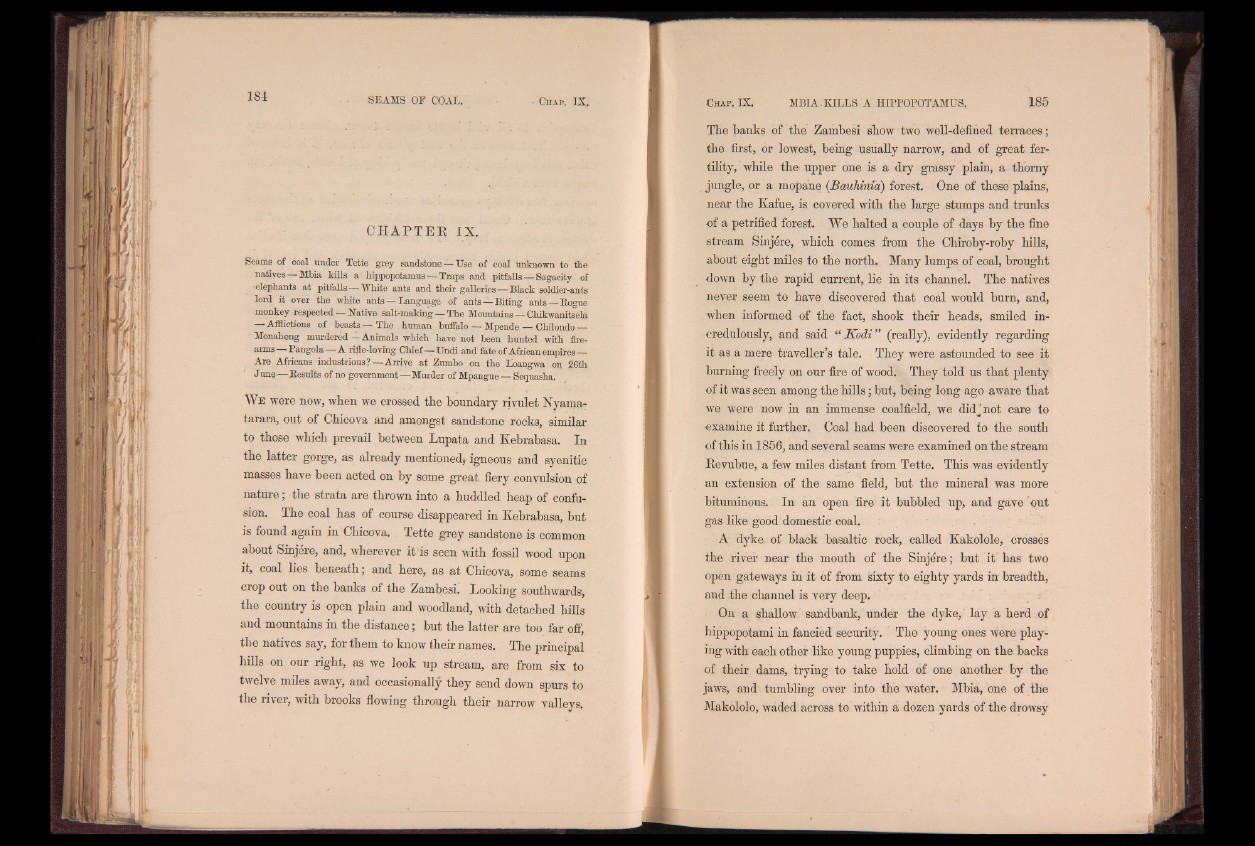
C H A P T E R IX .
Seams of coal under Tette grey sandstone — Use' of coal unknown to tie
natives — Mbia kills a hippopotamus — Traps and pitfalls — Sagacity of
■elephants at pitfalls — White ants and their galleries—Black soldier-ants
lord it over the white ants — Language of ants —Biting ants—Bogue
monkey respected Native salt-making — The Mountains —- Chikwanitsela
Afflictions of beasts —- The human buffalo --— Mpende -— Chilondo ■—•
Monaheng murdered—Animals which have'not been hunted with firearms—
Pangola—A rifle-loving Chief—TJndi and fate of African empires —
Are Africans industrious? — Arrive at Zumbo on the Loangwa on 26th
June — Besults of no government — Murder of Mpangue — Sequasha.
W e were now, when we crossed the boundary rivulet Nyama-
tarara, out of Chicova and amongst sandstone rocks, similar
to those which prevail between Lupata and Kebrabasa, In
the latter gorge, as already mentioned, igneous and syenitic
masses have been acted on by some great fiery convulsion of
nature; the strata are thrown into a huddled heap of confusion.
The coal has of course disappeared in Kebrabasa, but
is found again in Chicova. Tette grey sandstone is common
about Sinjere, and, wherever it is seen with fossil wood upon
it, coal lies beneath; and here, as at Chicova, some seams
crop out on the banks of the Zambesi. Looking southwards,
the country is open plain and woodland, with detached bill«
and mountains in the distance; but the latter are too far off,
the natives say, for them to know their names. The principal
hills on our right, as we look up stream, are from six to
twelve miles away, and occasionally they send down spurs to
the river, with brooks flowing through their narrow valleys.
The banks of the Zambesi show two well-defined terraces;
the first, or lowest, being usually narrow, and of great fertility,
while the upper one is a dry grassy plain, a thorny
jungle, or a mopahe (Bauhiriia) forest. One of these plains,
near the Kafue, is covered with the large stumps and trunks
of a petrified forest. We halted a couple of days by the fine
stream Sinjere, which comes from the Chiroby-roby hills,
about eight miles to the north. Many lumps of coal, brought
down by the rapid current, lie in its channel. The natives
never seem to have discovered that coal would burn, and,
when informed of the fact, shook their heads, smiled incredulously,
and said “ Kodi I (really), evidently regarding
it as a mere traveller’s tale. They were astounded to see it
burning freely on our fire of wood. They told us that plenty
of it was seen among the hills; but, being long ago aware that
we were now in an immense coalfield, we didj not care to
examine it further. Coal had been discovered to the south
of this in 1856, and several seams were examined on the stream
Revubue, a few miles distant from Tette. This was evidently
an extension of the same field, but the mineral was more
bituminous. In an open fire it bubbled up, and gave out
gas like good domestic coal.
A dyke., of black basaltic rock, called Kakolole, crosses
the river near the mouth of the Sinjere; but it has two
open gateways in it ¿f from sixty to eighty yards in breadth,
and the channel is very deep,
On a shallow sandbank, under the dyke, lay a herd of
hippopotami in fancied security. The young ones were playing
with each other like young puppies, climbing on the backs
of their dams, trying to take hold of one another by the
jaws, and tumbling over into the wTater. Mbia, one of the
Makololo, waded across to within a dozen yards of the drowsy